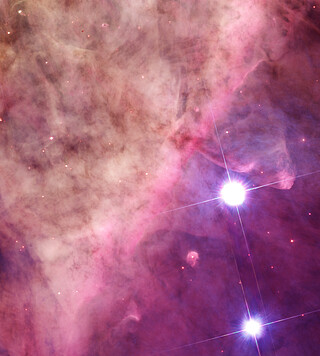Hubble and Webb showcase part of the Orion Nebula
An international team of scientists have used data collected by the NASA/ESA/CSA James Webb Space Telescope to detect a molecule known as the methyl cation (CH3+) for the first time, located in the protoplanetary disc surrounding a young star. They accomplished this feat with a cross-disciplinary expert analysis, including key input from laboratory spectroscopists. The vital role of CH3+ in interstellar carbon chemistry has been predicted since the 1970s, but Webb’s unique capabilities have finally made observing it possible — in a region of space where planets capable of accommodating life could eventually form.
The Orion Nebula has been studied by astronomers for hundreds of years, and it has been a frequent target of the Hubble Space Telescope since its launch. This comparison shows the striking difference in views afforded by a visible-light telescope, such as Hubble, and an infrared telescope like Webb.
In Webb’s image on the left, near-infrared light is able to penetrate the dust, but the heated gas also emits its own infrared light, making for a colourful scene with filaments and cavities. On the right in the Hubble image, which was taken during 2004 and 2005, bubbles of gas appear to float in front of the thick, smoky clouds of the nebula. Numerous new stars, some with protoplanetary discs, are visible across both images.
Credit:NASA & ESA
About the Images
| Id: | weic2315 | |
|---|---|---|
| Release date: | 26 June 2023, 17:00 | |
| Related releases: | weic2315 | |





